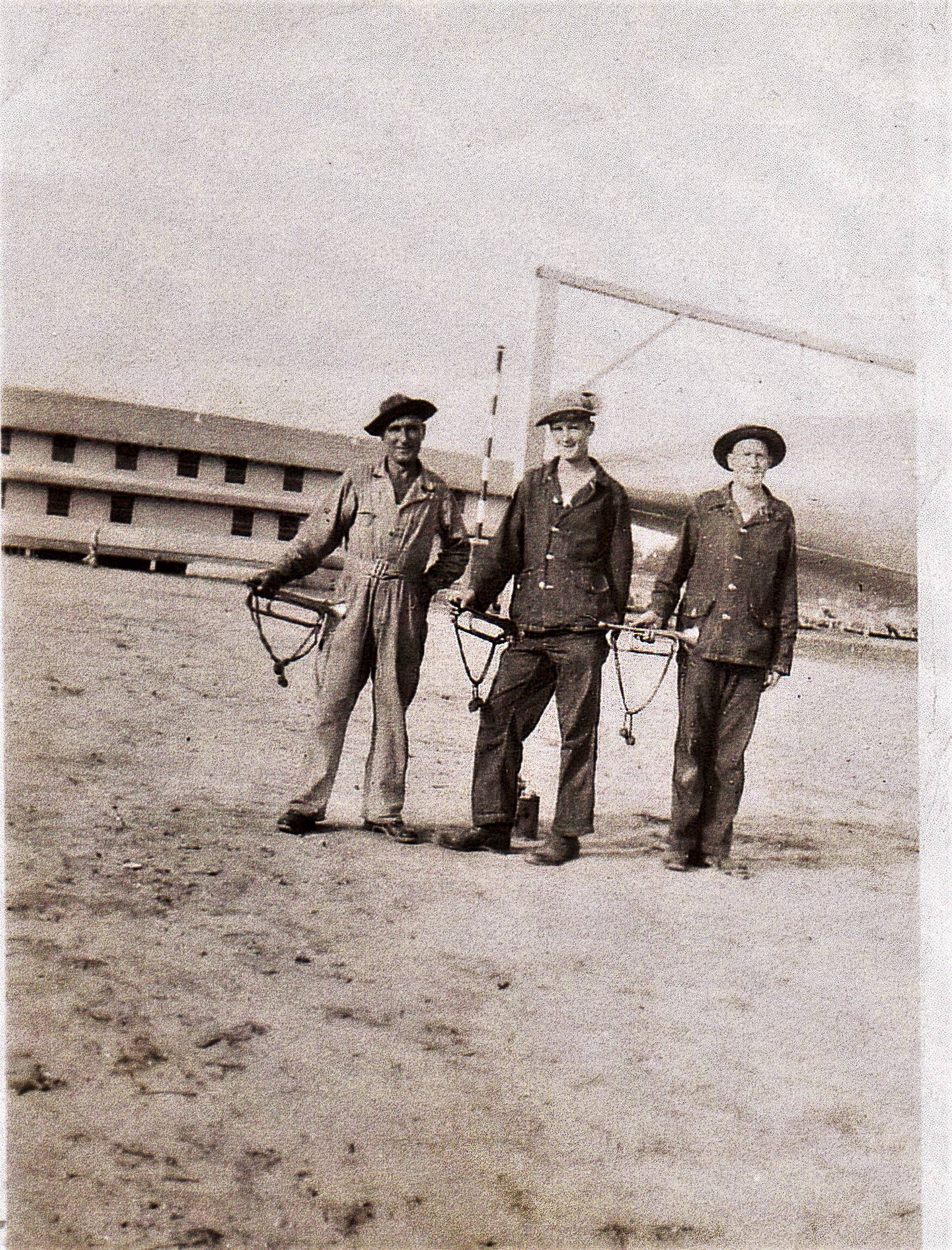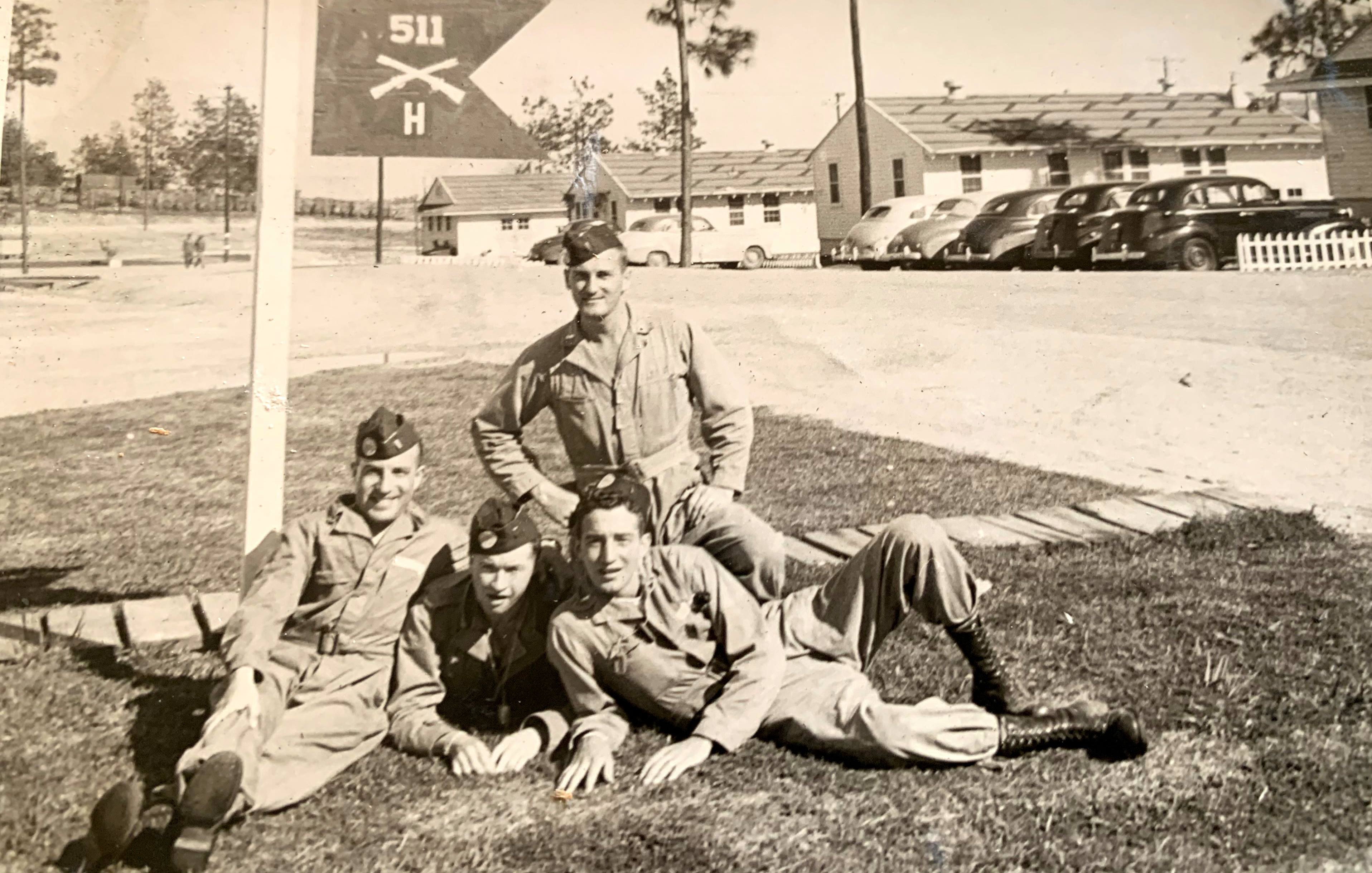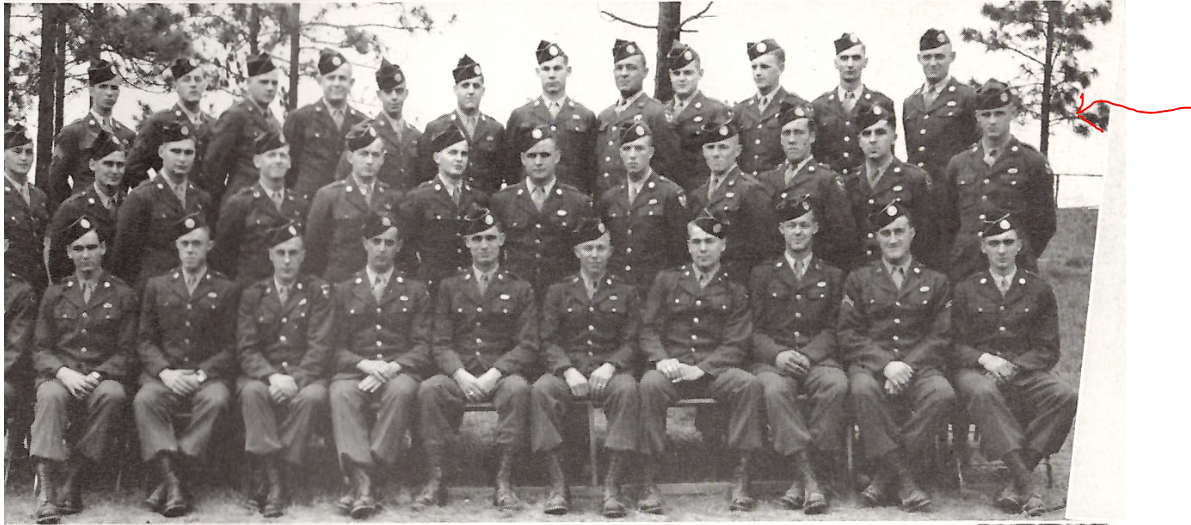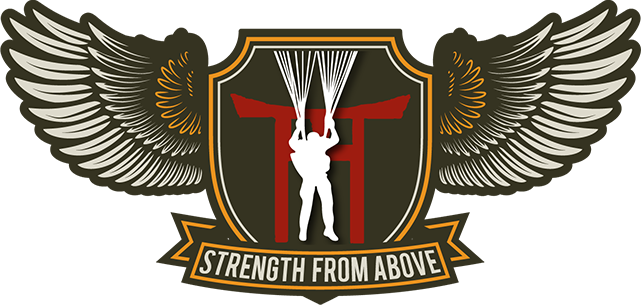S/Sgt. Barker, Robert B.

Company H, 511th PIR
December 31, 1924 - June 26, 2006 (Age 81) - gravesite
Citations: Silver Star, Bronze Star, Purple Heart, Presidential Unit Citation, World War II Victory Medal, Philippine Presidential Unit Citation Badge, Philippine Liberation Medal with service star, the American Defense Medal, and the Asiatic-Pacific Campaign Medal with three Battle Stars and one Arrowhead
Robert Brown "Bobby" Barker was born on December 31, 1924 in Chattanooga, Tennessee to Robert Jasper Barker and Roxanne "Roxie" Adelaide Brown. Two years later his sister Janet Ruth was born followed by their younger brother Theodore, or "Ted" in 1927. Bob and his siblings grew up in Chattanooga where Bob attended Dickinson Junior High and Chattanooga High schools. In 1940, Bob's father died at the age of 34. Now only 15 years of age, Bob enlisted in the National Guard in a Calvary unit, then officially entered the service the following year on February 24, 1941 at age 16 when his unit converted to an artillery unit.
 Two years later in March of 1943, Bob was sent to Fort Oglethorpe, Georgia where he volunteered for America's new parachute troops and was sent to Camp Toccoa, Georgia to join the newly-forming 511th Parachute Infantry Regiment under Colonel Orin D. "Hard Rock" Haugen. The barely-18-years-old Bob was assigned to Company H under Captain Patrick McGinnis. After enduring Toccoa's difficult training regime, including running up and down the famous Mount Currahee, Bob and H Company headed for Camp Mackall, North Carolina to join the 1st and 2nd Battalions. The 511th PIR was now officially part of the 11th Airborne Division, "The Angels", under Major General Joseph May Swing.
Two years later in March of 1943, Bob was sent to Fort Oglethorpe, Georgia where he volunteered for America's new parachute troops and was sent to Camp Toccoa, Georgia to join the newly-forming 511th Parachute Infantry Regiment under Colonel Orin D. "Hard Rock" Haugen. The barely-18-years-old Bob was assigned to Company H under Captain Patrick McGinnis. After enduring Toccoa's difficult training regime, including running up and down the famous Mount Currahee, Bob and H Company headed for Camp Mackall, North Carolina to join the 1st and 2nd Battalions. The 511th PIR was now officially part of the 11th Airborne Division, "The Angels", under Major General Joseph May Swing.
While we will generally outline Bob's timeline in the war, the general history of the 511th Parachute Infantry Regiment are covered in full in the new book, WHEN ANGEL'S FALL: FROM TOCCOA TO TOKYO, THE 511TH PARACHUTE INFANTRY REGIMENT IN WORLD WAR II, available in the regimental online store, on Amazon or wherever military history books are sold.
A month or so after the move to Camp Mackall, Bob and his buddies were sent to Jump School at Fort Benning, Georgia where they earned their jump wings, "The Silver Badge of Courage", and became United States paratroopers. Bob and the Angels continued their training stateside at Camp Mackall, and participated in the historic Knollwood Maneuvers in December of 1943. In early 1944 the division headed for Camp Polk, Louisiana for more training and final testing before heading overseas. They boarded a train for Camp Stoneman, California in April then boarded the SS Sea Pike on May 21 for a three week "cruise" across the Pacific Ocean. Their destination: Dobodura, New Guinea.
During the voyage, which was generally detested by the paratroopers, the ship's Merchant Marine captain Robert Adams once got on the ship's PA system to shout, "Sergeant Devereux, stow that smoke. You have two minutes before I put a hose down your stack."
S/Sgt. Devereux W. Pedley’s H Company comrades, perhaps including Robert Barker, jumped in, shouting, "Kill Sergeant Devereux, throw Sergeant Devereux overboard, shoot Sergeant Devereux." followed, of course, by riotous laughter.
At Dobodura, Bob and the 511th PIR were officially in "Strategic Reserve" from May - October 1944. The Angels would spend those months in theater training and acclimatization. Then, on November 7, 1944, Bob and the 511th departed New Guinea for Leyte where the division was first committed to combat. Bob's H Company fought with the regiment from the east coast of the island to the west coast. For 33 days, the young paratroopers endured monsoon rains, mud, hunger, thirst, enemy banzai attacks, frontal assaults, elusive snipers, incessant insects, and more. As one trooper later declared, "After Leyte, Hell was a vacation."
To provide the reader with just one example of the fighting environment, on December 19 Bob and H Company, along with I Company, were ordered to take what the Angels deemed "Maggot Hill", so named because of the abundance of maggots eating the Japanese dead. The division's 457th Parachute Field Artillery Battalion bombarded the hill with their 75mm pack howitzers before H and I Companies began their assaults, firing as they struggled in the mud and soon encountered the Japanese MLR. Hours later, after utilizing flame throwers and demolitions, the hill was theirs and the paratroopers counted 432 of the enemy dead. They renamed the crest McGinnis Hill in honor of H Company’s CPT Patrick McGinnis who led the charge.
It was on Leyte, on November 30, that Robert, now a Staff Sergeant, was awarded the Silver Star "for conspicuous gallantry and intrepidity in connection with military operations against the enemy while serving with the 511th Parachute Infantry Regiment, 11th Airborne Division... Staff Sergeant Barker single-handedly attacked and destroyed an enemy machine gun nest, enabling his unit to continue its attack and seize its objective. His daring and heroic actions set an inspiring example for his unit and was in keeping with the finest traditions of the military service." (Headquarters, 11th Airborne Division, General Orders No. 18 (1945))
Years later he would recount to a friend that his squad was supposed to "flank them on the right side." Believing that the order meant to flank the Japanese on the right side, Bob came upon the enemy machine gun nest and instead of giving away their own position with rifle fire, Bob charged the nest, alone, and bayoneted the Japanese machine gunner(s).
After a few weeks of recuperation, Bob and H Company next participated in the regimental drop on Luzon's Tagaytay Ridge just south of Manila on February 3, 1945. H Company then joined in the division's push northward into southern Manila where they encountered the vicious Genko Line, Japan's 6,000 yard-deep defensive line consisting of pillboxes, reinforced bunkers, naval and anti-aircraft guns set to fire on the low angle, and enemy defenders who fought to the last.
The 511th PIR suffered tremendous casualties in this portion of their Luzon campaign, especially between February-June. Bob's H Company dropped on Tagaytay Ridge with 121 men; on February 12, just 8 days later, the company was down to 49. Bob himself would be wounded a little over a month later on March 23 outside Iban, just one day before the regiment trucked to Batangas and Bauan for roughly three weeks of recuperation.
 In April and May of 1945, Bob and H Company were involved in the difficult campaign to clear the Mount Malepunyo mountain range, including Mounts Macolod and Mataas Na-Bundok. The 11th Airborne took heavy casualties in taking the hills and mountains of southern Luzon, but had destroyed what remained of Gen. Masatoshi Fujishige’s Southern Defense Force, the Fuji Heidan, and eliminated 2,500 of the enemy around the Malepunyo range.
In April and May of 1945, Bob and H Company were involved in the difficult campaign to clear the Mount Malepunyo mountain range, including Mounts Macolod and Mataas Na-Bundok. The 11th Airborne took heavy casualties in taking the hills and mountains of southern Luzon, but had destroyed what remained of Gen. Masatoshi Fujishige’s Southern Defense Force, the Fuji Heidan, and eliminated 2,500 of the enemy around the Malepunyo range.
Due to their reduced strength, H Company did not take part in the Task Force Gypsy operation at Aparri, but throughout July and August the 11th Airborne was busy prepping for the anticipated invasion of Japan which was thankfully called off after Japan surrendered. Bob and H Company were some of the first Allied soldiers to touch down on Japan at the Atsugi Aerodrome on August 31, 1945, only a few hours before General Douglas MacArthur himself landed.
S/SGT Barker was selected to take part in General MacArthur's Honor Guard at Atsugi and then during the first few weeks on Japan. This was a great honor, one that indicates the caliber of paratrooper that Bob was considering he was selected from an airborne division that was considered one of the most elite units in the US Army at the time. To learn more about what Bob and the other distinguished members of the Honor Guard did during this special duty, please read this article.
After the Surrender Ceremony, Bob remained in occupation duty until November of 1945 when he returned home for an honorable discharge after over five years of military service. The combat veteran then went to work for the U.S. Railway mail in December, a career that lasted over 23 years before he went to work for the United States Postal Service. In 1949 he married Doris Arledge and together they had 4 children. With a smile and a twinkle in his eye, Bob described Doris as "fresh out of high school!" His loving daughter, Leslie, described Bob as, "Hardworking, honest, and great dad... above all a good Christian and kind person."
Bobby once explained some of his worth ethic, stating, "If you want to work, you can get a job. If you will WORK. In other words, if you're on time, and you're there every day, people want you. But if that couldn't matter one way or another, ain't nobody gonna hire you."
Bob never regretted serving his country, and was proud to have done so. He said, "Freedom is the opportunity to choose. You can go to any grocery store you want to; any church you want to; you drive the kind of car you want to. Thank goodness we don't all think alike! That's freedom."
He then added, "Its a high price for freedom, but it is worth it. You don't have a house and not protect it. So, we've got to protect our democracy. And if it happened, and I was young enough, I'd do it again."
After his beloved Doris passed away in 1983, Bob became heavily involved in his local church where he served for many years. Then, after overcoming throat cancer, S/SGT Robert Brown Barker passed away in his hometown of Chattanooga, Tennessee, on May 26, 2006 at the age of 81. Lest We Forget.
YouTubeR Error: Videos IDs: JxlcbB1qwns not found


To learn more about the 11th Airborne Division in World War II, please consider purchasing a copy of our books on the Angels:

